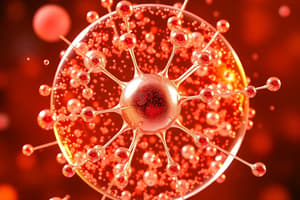Podcast
Questions and Answers
What type of substance cannot be decomposed into a simpler substance by heat and/or electricity?
What type of substance cannot be decomposed into a simpler substance by heat and/or electricity?
- Element (correct)
- Solution
- Compound
- Mixture
Which term describes a substance that contains two or more elements in a fixed unchanging ratio?
Which term describes a substance that contains two or more elements in a fixed unchanging ratio?
- Solute
- Solution
- Compound (correct)
- Mixture
Which process can separate a mixture into its components based on differences in boiling points?
Which process can separate a mixture into its components based on differences in boiling points?
- Distillation (correct)
- Evaporation
- Sublimation
- Filtration
What term describes a homogeneous mixture of a solute and a solvent?
What term describes a homogeneous mixture of a solute and a solvent?
Which type of matter takes up space and has mass?
Which type of matter takes up space and has mass?
What is the term used for a substance that keeps its chemical identity and can be separated by physical means?
What is the term used for a substance that keeps its chemical identity and can be separated by physical means?
What happens to the temperature of a solid as it starts to melt?
What happens to the temperature of a solid as it starts to melt?
How do impurities affect the melting point of a substance?
How do impurities affect the melting point of a substance?
What indicates that a substance is not pure based on its melting point?
What indicates that a substance is not pure based on its melting point?
Why does a substance with impurities have a lower melting point range?
Why does a substance with impurities have a lower melting point range?
How can a boiling point be identified using heating or cooling curves?
How can a boiling point be identified using heating or cooling curves?
What is an effect of having impurities in a substance when determining its melting point?
What is an effect of having impurities in a substance when determining its melting point?
What does a solubility curve plot?
What does a solubility curve plot?
In the context of solubility, what does a saturated solution mean?
In the context of solubility, what does a saturated solution mean?
What happens when a saturated solution of KClO3 at 70 oC is cooled to 30 oC?
What happens when a saturated solution of KClO3 at 70 oC is cooled to 30 oC?
What is the classification of matter for compounds?
What is the classification of matter for compounds?
Which statement correctly describes elements?
Which statement correctly describes elements?
What is the main characteristic of mixtures?
What is the main characteristic of mixtures?
Flashcards are hidden until you start studying
Study Notes
Types of Substances
- An element is a substance that cannot be decomposed into a simpler substance by heat and/or electricity.
- A compound is a substance that contains two or more elements in a fixed, unchanging ratio.
Separation of Mixtures
- Distillation is the process that separates a mixture into its components based on differences in boiling points.
Mixtures and Solutions
- A solution is a homogeneous mixture of a solute and a solvent.
Properties of Matter
- Matter is anything that takes up space and has mass.
Purification of Substances
- A substance that keeps its chemical identity and can be separated by physical means is called a pure substance.
- When a solid starts to melt, its temperature remains constant.
- Impurities in a substance lower its melting point, resulting in a range of melting points rather than a single point.
- A substance is not pure if its melting point range is wide, indicating the presence of impurities.
- A heating or cooling curve can be used to identify a boiling point.
- Impurities in a substance affect its melting point, making it difficult to determine its true melting point.
Solubility
- A solubility curve plots the relationship between temperature and the amount of solute that dissolves in a solvent.
- A saturated solution is one that contains the maximum amount of solute that can dissolve at a given temperature.
- When a saturated solution of KClO3 at 70°C is cooled to 30°C, it becomes supersaturated, meaning it contains more solute than it can hold at the lower temperature.
- Compounds are classified as a type of matter.
- Elements are substances that consist of only one type of atom.
- Mixtures are characterized by having variable compositions and properties.
Studying That Suits You
Use AI to generate personalized quizzes and flashcards to suit your learning preferences.



